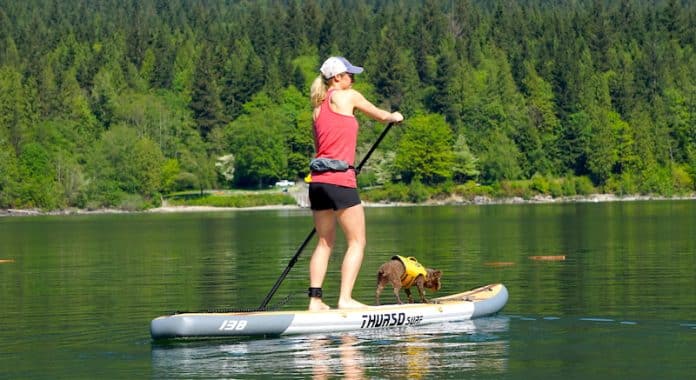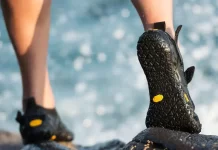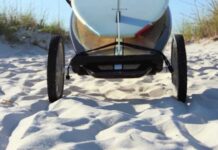Stand-up paddle boarding has been gaining popularity as an enjoyable water sport for people of all ages. However, the question often arises as to whether one needs a personal floatation device (PFD) while engaging in this activity.
In this article, we aim to explore the importance of PFDs for stand-up paddle boarding and provide essential information to ensure your safety on the water.
So, whether you’re a beginner or an experienced paddler, read on to discover the answer to the crucial question, “Do I need a PFD for stand-up paddle boarding?”
Why PFDs are essential for stand-up paddle boarding
Stand up paddle boarding (SUP) has become a popular water activity recently. While it offers a fun experience, it is crucial to prioritize safety on the water. One important safety measure that should never be overlooked is using personal flotation devices (PFDs). PFDs, also known as life jackets, are designed to increase safety and provide flotation in case of accidents or emergencies. Let’s explore why PFDs are essential for stand up paddle boarding.
PFDs increase safety in the water.
Safety should always be our top priority when engaging in any water activity, and stand up paddle boarding is no exception. Accidents can happen unexpectedly, and having a PFD can significantly increase our chances of staying safe on the water. Whether we consider ourselves strong swimmers or not, unforeseen circumstances can arise, and having a PFD ensures that we have a reliable means of staying afloat and increasing our chances of survival.
PFDs provide flotation in case of an accident.
No matter how confident we are in our paddling skills, accidents can still occur while stand up paddle boarding. It only takes a momentary lapse in concentration or an unexpected change in weather conditions to find ourselves in a distressing situation. PFDs provide the necessary flotation to keep us buoyant in the water, even if we become tired or injured. This extra support can be a lifesaver in critical moments, giving us a fighting chance to stay afloat until help arrives.
PFDs can assist in self-rescue situations.
While we hope to never find ourselves in a situation where we must rescue ourselves, it’s essential to be prepared for such scenarios. PFDs can assist in self-rescue situations by providing additional buoyancy and allowing us to conserve energy while awaiting rescue or returning to safety. In the event of solid currents or becoming separated from our board, a PFD can make all the difference in maneuvering through challenging water conditions and ensuring our safety.
Legal requirements for PFDs in stand up paddle boarding
Understanding the legal requirements for PFD usage in stand up paddle boarding is vital for ensuring compliance and maintaining our safety. These requirements can vary depending on federal regulations, state-specific laws, regulations concerning PFD usage, and specific requirements for children.
Federal regulations on PFD usage
The United States Coast Guard (USCG) has established federal regulations regarding using PFDs for recreational boating activities, including stand up paddle boarding. According to these regulations, PFDs must be readily accessible for each person on board and of the appropriate size for each individual. Inflatable PFDs must be worn and inflated adequately before entering the water.
State-specific laws and regulations
In addition to federal regulations, each state may have laws and regulations regarding using PFDs while engaging in stand-up paddle boarding. We must familiarize ourselves with the state’s specific requirements in which we plan to paddle. This information is typically found on the state’s official boating or outdoor recreation website or obtained from local authorities.
PFD requirements for children
It is essential to pay special attention to the PFD requirements for children when participating in stand up paddle boarding as a family. Federal regulations mandate that children under 13 wear a USCG-approved PFD while on a recreational vessel, including paddleboards. Children’s PFDs must also be appropriately sized to ensure a snug fit and optimal safety.
Different types of PFDs for stand up paddle boarding
When choosing a PFD for stand-up paddle boarding, selecting the one that suits our specific needs and preferences is crucial. There are different types of PFDs available, each designed for various water activities and conditions.
Type I PFDs
Type I PFDs, or offshore life jackets, are designed for rough or open water conditions where rescue may be delayed. They provide the highest level of buoyancy and are typically oversized to accommodate heavy clothing and equipment. While Type I PFDs offer excellent flotation, they may not be the most practical choice for stand up paddle boarding, as they can be bulky and restrict movement.
Type II PFDs
Type II PFDs are commonly known as near-shore buoyant vests and are suitable for calm or inland waters where rescue is expected to be prompt. They provide moderate buoyancy and are more comfortable and less bulky than Type I PFDs. Type II PFDs are popular for stand-up paddle boarding due to their versatility and ease of use.
Type III PFDs
Type III PFDs are the most commonly used PFDs for recreational activities, including stand up paddle boarding. They are designed for calm waters and offer a good balance between mobility and buoyancy. Type III PFDs allow for a more excellent range of motion, making them ideal for paddle sports. These PFDs are available in a variety of styles, including vests and waist packs, providing options for personal preference.
Type IV PFDs
Type IV PFDs are throwable devices, such as ring or horseshoe buoys, designed to be thrown at a distressed person to provide additional flotation. While these devices can be helpful for rescue purposes, they are unsuitable for self-rescue or wearing while paddle boarding. Having a Type IV PFD on board our paddleboard is essential to ensure compliance with federal regulations.
Type V PFDs
Type V PFDs encompass specialized PFDs designed for specific water activities, such as paddle sports. These PFDs are intended for specific conditions and may require additional activation or attachment methods. It is essential to carefully read and follow the manufacturer’s instructions to ensure proper use and effectiveness.
Choosing the correct PFD for stand up paddle boarding
With the various PFDs available, finding the right one for stand up paddle boarding can seem overwhelming. However, considering a few key factors can help us make an informed decision.
Consider the intended use and conditions.
Before selecting a PFD, we must consider the stand-up paddle boarding we plan to engage in and the conditions we expect to encounter. Will we be paddling on calm lakes or venturing into the open ocean? Will we be exploring calm rivers or navigating through whitewater rapids? The intended use and conditions will dictate the buoyancy and maneuverability needed.
Ensure a proper fit.
A properly fitting PFD is essential for optimal safety and comfort. When trying on a PFD, we should ensure that it fits snugly but allows for freedom of movement. Testing the fit by raising our arms is recommended, as this mimics the movements we will make while paddle boarding. Adjustable straps and buckles can help tailor the fit to our body shape and size.
Check for US Coast Guard approval.
We should look for the US Coast Guard approval label to ensure that the PFD we choose meets safety standards. This label guarantees that the PFD has undergone rigorous testing and meets the necessary criteria for flotation and performance. It is important not to substitute other flotation devices, such as pool noodles or inflatable toys, for an approved PFD.
Extra features to consider
While the primary function of a PFD is to provide flotation and ensure safety, some PFDs offer additional features that may enhance our stand-up paddle-boarding experience. These features can include pockets for storing small items; attachment points for accessories such as whistles or lights, and reflective materials for increased visibility in low-light conditions. These extra features can help us find a PFD that fits our needs and preferences.
Benefits of wearing a PFD while stand up paddle boarding
The benefits of wearing a PFD while stand up paddle boarding go beyond simply complying with legal requirements. Let’s explore some of the advantages that wearing a PFD can offer.
Prevention of drowning
Drowning is a significant risk when participating in water activities, and wearing a PFD significantly reduces this risk. A PFD ensures that we remain afloat even if we become exhausted, incapacitated, or injured. It gives us the necessary buoyancy to keep our head above water and breathe, giving us precious time for rescue or self-rescue.
Added buoyancy for beginners
For beginners who are just getting started with stand up paddle boarding, a PFD can provide an extra level of confidence and stability. The added buoyancy of a PFD can help beginners feel more secure on the water, allowing them to focus on improving their balance and paddle strokes without the fear of sinking. This added support can make the learning experience more enjoyable and encourage beginners to continue pursuing the sport.
Peace of mind for individuals
Wearing a PFD can provide individuals with a sense of peace of mind while engaging in stand up paddle boarding. Knowing that we have a reliable flotation device can alleviate anxiety and allow us to enjoy the experience fully. This peace of mind also extends to our loved ones, who can rest assured that we are taking the necessary precautions to stay safe on the water.
Potential risks of stand up paddle boarding without a PFD
While stand up paddle boarding is generally considered a safe water activity, there are potential risks when not wearing a PFD. Understanding these risks can emphasize the importance of using a PFD and encourage responsible water recreation.
Increased risk in case of falls or collisions
Stand up paddle boards require balance and stability, and falls are common, especially for beginners or in rougher water conditions. Without a PFD, even a simple fall can result in severe consequences. The impact of falling on the water can disorient us and potentially lead to injury or panic. A PFD can provide the necessary flotation to keep us safe and prevent accidents from turning into tragedies.
Hypothermia in cold water
Cold water can pose a significant risk, even in seemingly calm conditions. In unexpected immersion in cold water, the body can quickly lose heat, leading to hypothermia. Without a PFD, the energy required to stay afloat and keep the body above water can contribute to rapid heat loss. Wearing a PFD provides buoyancy and helps insulate the body, reducing the risk of hypothermia and increasing the chances of survival.
Difficulties in emergencies
Emergencies can happen without warning, and the ability to respond quickly and effectively is crucial. Without a PFD, individuals may struggle to stay afloat and reach safety during an emergency. A PFD’s added buoyancy and support can make a critical difference in such situations, allowing individuals to conserve energy and focus on finding a solution.
Tips for wearing a PFD while stand up paddle boarding
To ensure our safety and make the most of our stand up paddle boarding experience, it is essential to wear a PFD correctly and follow these tips:
Ensure secure and proper fit
Before heading out on the water, we must ensure that our PFD is securely fastened and properly fitted to our body. Adjustable straps and buckles should be tightened to ensure a snug fit, but not too tight to restrict movement or cause discomfort. It is also essential to regularly check and readjust the PFD as needed during the paddle to ensure it remains appropriately fitted.
Keep the PFD accessible and easily visible.
Easy access to the PFD is paramount in an emergency or unexpected situation. Paddleboarders should wear their PFDs at all times while on the water. Additionally, the PFD should be positioned where it is easily visible to others, ensuring that rescuers or fellow paddlers can quickly identify that we are wearing a PFD.
Practice self-rescue techniques with a PFD
Knowing how to perform self-rescue techniques while wearing a PFD is crucial for our safety and confidence on the water. Practicing self-rescue techniques, such as climbing back onto the paddleboard, is recommended while wearing a PFD in controlled environments and calm waters. This practice allows us to familiarize ourselves with the process and build the skills necessary to effectively rescue ourselves in case of accidental falls or mishaps.
Common misconceptions about PFDs in stand up paddle boarding
Despite the importance of PFDs in stand-up paddle boarding, some common misconceptions can lead individuals to neglect wearing them. Let’s address and debunk these misconceptions:
PFDs limit freedom of movement
One of the most prevalent misconceptions is that PFDs limit freedom of movement while stand up paddle boarding. While it is true that some PFDs can be more restrictive than others, advancements in PFD design have led to the development of PFDs specifically tailored for paddle sports. Type III PFDs, for example, are designed to provide optimal mobility without compromising safety. With proper selection and fit, paddleboarders can find a PFD that allows for a full range of motion, ensuring both safety and comfort.
Only weak swimmers need PFDs
Another common misconception is that only weak swimmers need to wear PFDs while stand up paddle boarding. No matter our swimming abilities, unexpected situations, fatigue, or injuries can render us incapable of staying afloat without assistance. PFDs are designed to provide additional support and buoyancy, making them crucial for all paddleboarders, regardless of their swimming skills.
Stand up paddle boarding is low-risk, so no PFD is necessary.
While stand up paddle boarding is generally considered a low-risk water activity, accidents and emergencies can still occur. Finding ourselves in a dangerous situation only takes a momentary distraction or a sudden change in weather conditions. Wearing a PFD ensures that we have the necessary safety precautions in place, regardless of the perceived risk level. Prioritizing safety should always be the rule, regardless of how safe an activity may seem.
Responsibilities of stand up paddle boarders in regard to PFD use
As stand up paddle boarders, we have specific responsibilities when it comes to PFD use. These responsibilities go beyond legal requirements, extend to personal accountability, and set an excellent example for others.
Personal accountability for safety
Each individual engaging in stand up paddle boarding has a personal responsibility for their safety and the safety of those around them. Wearing a PFD is one of the most critical steps to mitigate risks and ensure our well-being on the water. By taking personal accountability for our safety, we contribute to a culture of responsible paddleboarding and inspire others to do the same.
Setting a good example for others
Our actions and choices have the power to influence others. By consistently wearing a PFD while standing paddle boarding, we set a good example for others. This can be incredibly impactful for children and novice paddleboarders who may be observing our behavior. By prioritizing safety, we encourage a culture of responsible water recreation and promote a positive image of stand-up paddle boarding as a safe and enjoyable activity.
Staying informed about local regulations
Stand up paddle boarders should stay informed about local regulations regarding the use of PFDs. These regulations can vary by location and may be subject to change. By remaining knowledgeable about the rules and regulations, we can ensure compliance and promote responsible paddleboarding within our communities.
Conclusion
Regarding stand-up paddle boarding, safety should always be at the forefront of our minds. Personal flotation devices (PFDs) are indispensable companions for stand up paddle boarders, offering increased safety, flotation in emergencies, and assistance in self-rescue situations. To comply with legal requirements and ensure optimal safety, it is crucial to choose the right type of PFD and wear it correctly.
Wearing a PFD provides numerous benefits, such as drowning prevention, added buoyancy for beginners, and peace of mind for individuals. Conversely, neglecting to wear a PFD can expose us to increased risks, such as difficulties in emergencies and the potential for hypothermia.
By following tips for wearing a PFD, debunking common misconceptions, and upholding our responsibilities as paddleboarders, we can contribute to a culture of safety and enjoyment on the water. So, before we embark on our next stand up paddle boarding adventure, remember to bring along our PFDs and paddle responsibly for a memorable and safe experience.





































